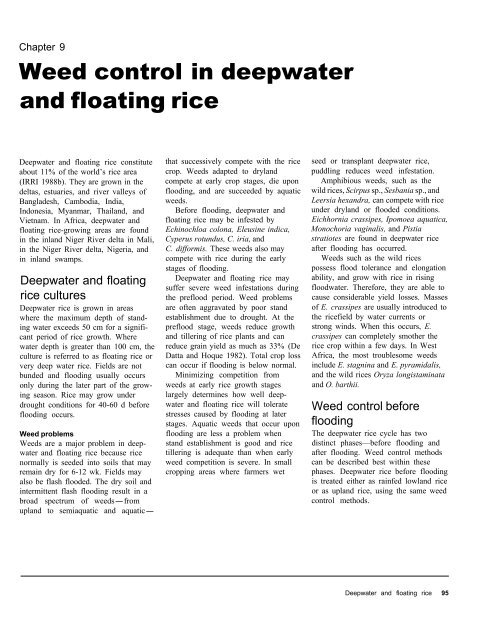A handbbok on Weed Control in Rice.pdf
A handbbok on Weed Control in Rice.pdf
A handbbok on Weed Control in Rice.pdf
Create successful ePaper yourself
Turn your PDF publications into a flip-book with our unique Google optimized e-Paper software.
Chapter 9<br />
<strong>Weed</strong> c<strong>on</strong>trol <strong>in</strong> deepwater<br />
and float<strong>in</strong>g rice<br />
Deepwater and float<strong>in</strong>g rice c<strong>on</strong>stitute<br />
about 11% of the world’s rice area<br />
(IRRI 1988b). They are grown <strong>in</strong> the<br />
deltas, estuaries, and river valleys of<br />
Bangladesh, Cambodia, India,<br />
Ind<strong>on</strong>esia, Myanmar, Thailand, and<br />
Vietnam. In Africa, deepwater and<br />
float<strong>in</strong>g rice-grow<strong>in</strong>g areas are found<br />
<strong>in</strong> the <strong>in</strong>land Niger River delta <strong>in</strong> Mali,<br />
<strong>in</strong> the Niger River delta, Nigeria, and<br />
<strong>in</strong> <strong>in</strong>land swamps.<br />
Deepwater and float<strong>in</strong>g<br />
rice cultures<br />
Deepwater rice is grown <strong>in</strong> areas<br />
where the maximum depth of stand-<br />
<strong>in</strong>g water exceeds 50 cm for a signifi-<br />
cant period of rice growth. Where<br />
water depth is greater than 100 cm, the<br />
culture is referred to as float<strong>in</strong>g rice or<br />
very deep water rice. Fields are not<br />
bunded and flood<strong>in</strong>g usually occurs<br />
<strong>on</strong>ly dur<strong>in</strong>g the later part of the grow-<br />
<strong>in</strong>g seas<strong>on</strong>. <strong>Rice</strong> may grow under<br />
drought c<strong>on</strong>diti<strong>on</strong>s for 40-60 d before<br />
flood<strong>in</strong>g occurs.<br />
<strong>Weed</strong> problems<br />
<strong>Weed</strong>s are a major problem <strong>in</strong> deep-<br />
water and float<strong>in</strong>g rice because rice<br />
normally is seeded <strong>in</strong>to soils that may<br />
rema<strong>in</strong> dry for 6-12 wk. Fields may<br />
also be flash flooded. The dry soil and<br />
<strong>in</strong>termittent flash flood<strong>in</strong>g result <strong>in</strong> a<br />
broad spectrum of weeds-from<br />
upland to semiaquatic and aquatic-<br />
that successively compete with the rice<br />
crop. <strong>Weed</strong>s adapted to dryland<br />
compete at early crop stages, die up<strong>on</strong><br />
flood<strong>in</strong>g, and are succeeded by aquatic<br />
weeds.<br />
Before flood<strong>in</strong>g, deepwater and<br />
float<strong>in</strong>g rice may be <strong>in</strong>fested by<br />
Ech<strong>in</strong>ochloa col<strong>on</strong>a, Eleus<strong>in</strong>e <strong>in</strong>dica,<br />
Cyperus rotundus, C. iria, and<br />
C. difformis. These weeds also may<br />
compete with rice dur<strong>in</strong>g the early<br />
stages of flood<strong>in</strong>g.<br />
Deepwater and float<strong>in</strong>g rice may<br />
suffer severe weed <strong>in</strong>festati<strong>on</strong>s dur<strong>in</strong>g<br />
the preflood period. <strong>Weed</strong> problems<br />
are often aggravated by poor stand<br />
establishment due to drought. At the<br />
preflood stage, weeds reduce growth<br />
and tiller<strong>in</strong>g of rice plants and can<br />
reduce gra<strong>in</strong> yield as much as 33% (De<br />
Datta and Hoque 1982). Total crop loss<br />
can occur if flood<strong>in</strong>g is below normal.<br />
M<strong>in</strong>imiz<strong>in</strong>g competiti<strong>on</strong> from<br />
weeds at early rice growth stages<br />
largely determ<strong>in</strong>es how well deep-<br />
water and float<strong>in</strong>g rice will tolerate<br />
stresses caused by flood<strong>in</strong>g at later<br />
stages. Aquatic weeds that occur up<strong>on</strong><br />
flood<strong>in</strong>g are less a problem when<br />
stand establishment is good and rice<br />
tiller<strong>in</strong>g is adequate than when early<br />
weed competiti<strong>on</strong> is severe. In small<br />
cropp<strong>in</strong>g areas where farmers wet<br />
seed or transplant deepwater rice,<br />
puddl<strong>in</strong>g reduces weed <strong>in</strong>festati<strong>on</strong>.<br />
Amphibious weeds, such as the<br />
wild rices, Scirpus sp., Sesbania sp., and<br />
Leersia hexandra, can compete with rice<br />
under dryland or flooded c<strong>on</strong>diti<strong>on</strong>s.<br />
Eichhornia crassipes, Ipomoea aquatica,<br />
M<strong>on</strong>ochoria vag<strong>in</strong>alis, and Pistia<br />
stratiotes are found <strong>in</strong> deepwater rice<br />
after flood<strong>in</strong>g has occurred.<br />
<strong>Weed</strong>s such as the wild rices<br />
possess flood tolerance and el<strong>on</strong>gati<strong>on</strong><br />
ability, and grow with rice <strong>in</strong> ris<strong>in</strong>g<br />
floodwater. Therefore, they are able to<br />
cause c<strong>on</strong>siderable yield losses. Masses<br />
of E. crassipes are usually <strong>in</strong>troduced to<br />
the ricefield by water currents or<br />
str<strong>on</strong>g w<strong>in</strong>ds. When this occurs, E.<br />
crassipes can completely smother the<br />
rice crop with<strong>in</strong> a few days. In West<br />
Africa, the most troublesome weeds<br />
<strong>in</strong>clude E. stagn<strong>in</strong>a and E. pyramidalis,<br />
and the wild rices Oryza l<strong>on</strong>gistam<strong>in</strong>ata<br />
and O. barthii.<br />
<strong>Weed</strong> c<strong>on</strong>trol before<br />
flood<strong>in</strong>g<br />
The deepwater rice cycle has two<br />
dist<strong>in</strong>ct phases—before flood<strong>in</strong>g and<br />
after flood<strong>in</strong>g. <strong>Weed</strong> c<strong>on</strong>trol methods<br />
can be described best with<strong>in</strong> these<br />
phases. Deepwater rice before flood<strong>in</strong>g<br />
is treated either as ra<strong>in</strong>fed lowland rice<br />
or as upland rice, us<strong>in</strong>g the same weed<br />
c<strong>on</strong>trol methods.<br />
Deepwater and float<strong>in</strong>g rice 95











